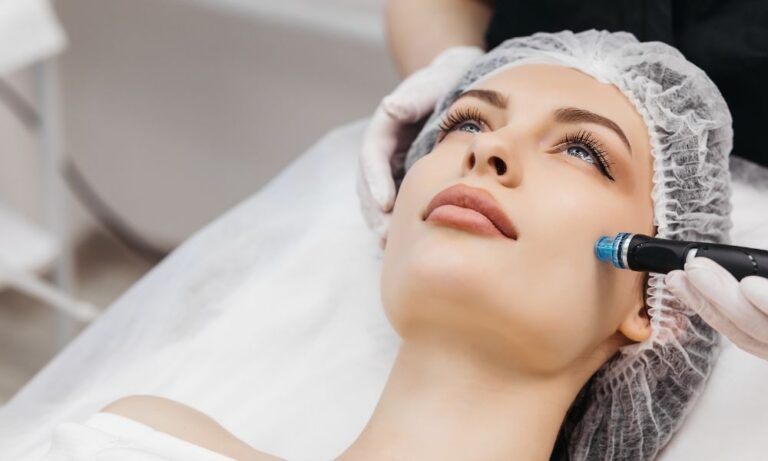What causes skin to lose its firmness as we age?
Dr Mark Gray: The breakdown of collagen and elastin are primary factors, however environmental elements such as wind, pollution and the sun can advance the process. A poor diet, smoking and excessive alcohol consumption can contribute. Intrinsic factors including genetics, ageing and hormones also play their part.
Caroline Parker: Age-related changes to the skin are due to genetic factors or programmed ageing (intrinsic ageing), and environmental wear and tear (extrinsic ageing). Extrinsic factors cause the most pronounced changes and it is estimated that 80-90 per cent of what we see on the skin as adults is the result of exposure to daylight, i.e. photoageing. Photoageing can manifest as wrinkles, a loss of tension and elasticity, degeneration of the vascular supply and skin thickness, a reduction in the water binding ability of the skin, dilated capillaries, hyper pigmentation and other skin discolouration.
How would you describe skin that lacks firmness?
Dr Mark Gray: Skin laxity is a general term that describes a series of changes to not only the physical appearance of the skin, but also the tone and texture. This is demonstrated over time as the skin loses its ability to reflect light effectively, leaving a sallow and dull complexion. Decreased hydration and elasticity leave the skin looking less smooth with a crepey appearance.
Caroline Parker: The underlying support structure of the skin is eroded due to intrinsic and extrinsic factors, and also the skin’s ability to retain moisture is inhibited. The skin experiences a loss of elasticity and firmness, is thinner and often dehydrated. Lines are deeper and more prominent, and the skin may be sagging.
Are there any particular areas of the face that commonly start to sag first?
Karen Barlow: The area often referred to as the ageing rectangle (from the top of the eyebrows to the jawline) is where signs of sagging and a lack of firmness start to appear first.
Dr Mark Gray: Changes are generally noted in the eye area first. Hooding of the upper eyelids can be one of the first signs of sagging skin. Sagging can also occur in the cheek area creating excess skin, making the lines from the nose to the mouth more prominent. Increased laxity of muscles to the lower face, especially the jawline, can also lead to the appearance of jowls.
Caroline Parker: We start to notice the effects of gravity underneath the jawline and exaggerated nasolabial lines (which extend from the nose to either side of the mouth). There is a loss of fat in the facial structure which contributes to the “hollows” and the lack of support cushion over the skull. In the fatty layer underneath the dermis – the hypodermis – the total number of fat cells declines, but they accumulate in particular areas resulting in bags under the eyes, and a double chin.
Armelle Souraud: There are three areas that predominantly show signs of sagging. Firstly, the eyelids, as the skin is particularly thin and fragile. Secondly, the contours of the face are highly exposed to gravity, especially if the cheekbones are not so prominent. Thirdly, the cheeks: if the nasolabial fold is pronounced, the lack of cheek firmness may be more visible.
What is a telltale sign that your skin is starting to sag?
Dr Mark Gray: A telltale sign of skin laxity is noticing a change in overall skin texture and tone, possibly noticing enlarged pores and fine lines appearing. Frequent comments of how tired you appear even though you are not feeling this way, may also be a sign of skin change.
Karen Barlow: Pinching the skin to see how quickly it springs back to its original position is a great test (skin with good elasticity will quickly resume its original position), but you can also look at the sides of your face near the ears. Often when gravity is taking over and a lack of firmness and sagging is present, you will see vertical lines appearing in this region.
Armelle Souraud: The most significant test to assess sagging skin is to lean the face on one’s side and gently pat the side that is facing the ground. This allows you to assess the lack of firmness on the cheek and face contour.
From what age can you expect to see a loss of skin firmness?
Caroline Parker: From about 30 onwards the natural rate of collagen production in our skin starts to decline at a rate of about 1 per cent per year. This rate rapidly increases during the five years after menopause. External factors, such as the amount of UV our skin has been exposed to, will also influence how quickly we see the signs of ageing. The climate and outdoor lifestyle in New Zealand and Australia results in accelerated skin ageing.
Besides using skincare products that are targeted at sagging skin, what can you do to prevent loss of skin firmness?
Dr Mark Gray: Consider taking vitamin C and omega oil-supplements daily. Vitamin C is known to support collagen production and is a great antioxidant that fights free radical damage and will benefit your immune system. Omega oils lubricate the skin and help reduce the dry crepey appearance. Daily dermal rolling with a home kit roller will keep the skin in renewal mode by stimulating natural collagen and improving the absorption of your skincare products. Clinic treatments can also be extremely effective in promoting the body to create new collagen, which helps prop up the structure of the skin giving it a more youthful and dewy appearance, and can be maintained over a longer period.
Caroline Parker: Extrinsic ageing (photoageing) impacts heavily on the dermis of our skin. Decrease photoageing by wearing a quality SPF on your skin every day. While the majority of UV damage occurs in the first 18-20 years of our life, it is never too late to start using SPF diligently.
Karen Barlow: Unfortunately we can’t prevent skin showing the signs of ageing, but we can delay it by using good-quality skincare products from a young age. Watch out for the sun as this is the most common cause of accelerated ageing and keep the skin well hydrated; this will improve the plumpness of your skin and assist with firmness.
Armelle Souraud: Because it is impossible to fight heredity and the biological clock, it is crucial to follow a healthy lifestyle with a balanced diet and avoid smoking, excessive amounts of alcohol and too much sun exposure.
Is it easier to prevent sagging skin than it is to treat it?
Dr Mark Gray: Absolutely. While we are younger our collagen production is much more prolific and of higher quality than when we are older – so prevention is always better than cure. This is not to say it’s not worthwhile having treatments when we are older – it may just take extra treatments to get the results.
Is it possible for the skin to regain its firmness?
Dr Mark Gray: Depending on the type of laxity of the skin it is possible to regain some firmness. You can use products to stimulate collagen production and tighten your skin or carry out more invasive procedures, which may significantly improve the look of your skin.
Caroline Parker: There is amazing technology available to increase skin firmness, especially in the area of protein fragments or peptides. Scientists can now identify the particular sequence and structure of amino acids that instruct cells to perform particular functions, such as producing more collagen.
What professional treatments would you recommend to treat lack of firmness?
Dr Mark Gray: Non-invasive, skin-firming treatments: Pixel laser for skin tightening and skin renewal; medical dermal rolling to promote skin freshening; Polaris or Matrix RF for skin tightening; and dermal fillers to regain contour and lost volume in the face. For surgical options: Removal of excess skin from upper eyelids and below the eyes; submental liposuction for jawline definition; and facelift to take years off your skin’s laxity. A combination of treatments will provide the best outcome.






